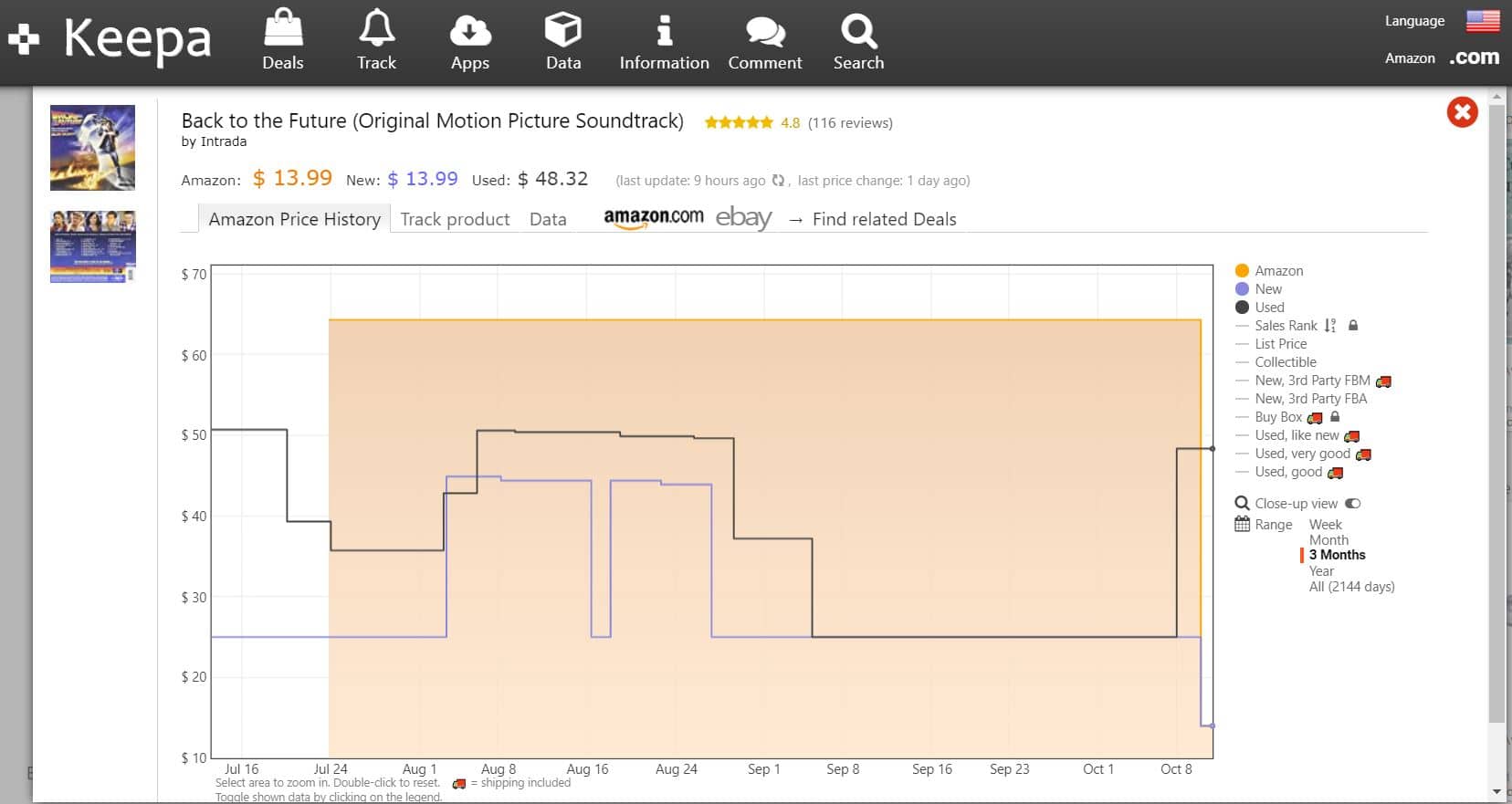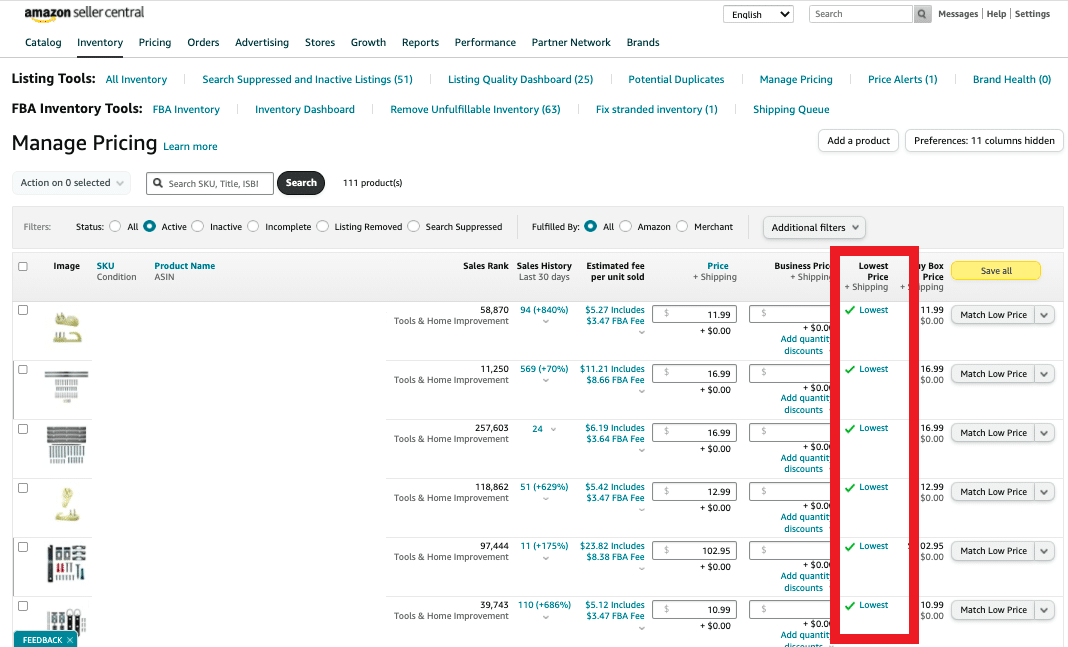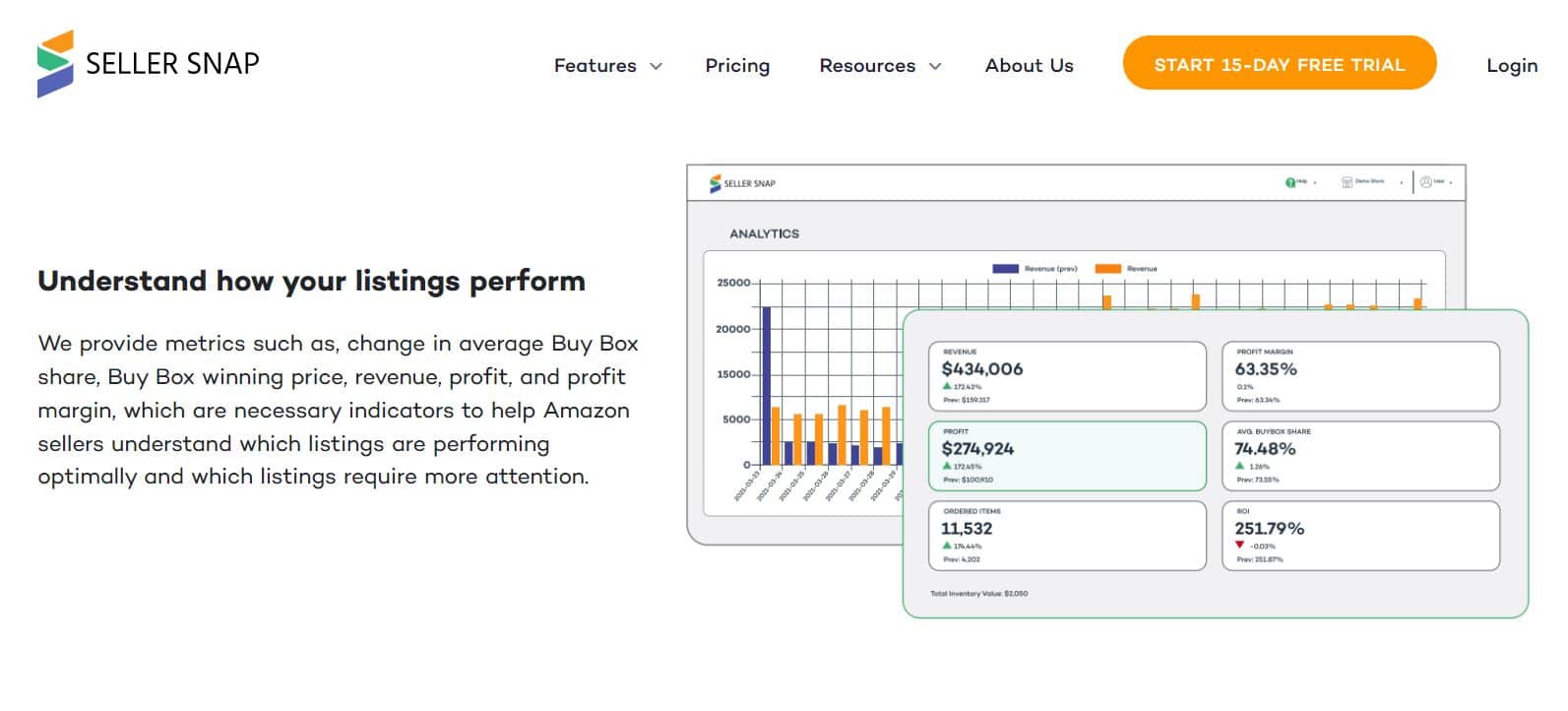Guide to Repricing Your Products on Amazon

Around 2.5 million price changes happen on Amazon every day. Whoever your competitor is, if they’re serious about making it on Amazon, you can be sure they have a repricing strategy in place. Let's take a look at some of the most effective repricing strategies that ensure you're always profitable and making the most out of your current seller position and Buy Box ownership.
Contents
Why Do Amazon Sellers Need to Reprice Their Products?
In general, repricing benefits sellers. When prices are adjusted properly, third-party sellers are able to maximize their profits. Even Amazon changes its prices multiple times a day in its own private-label brands.
Let's look at a few reasons why Amazon sellers reprice their products:
Reason 1: To get a bigger share of the Buy Box
Price is an important factor that the algorithm considers in awarding shares of the Buy Box. If your product is priced just right, in addition to hitting other seller metrics, you can have a better chance at the Buy Box.
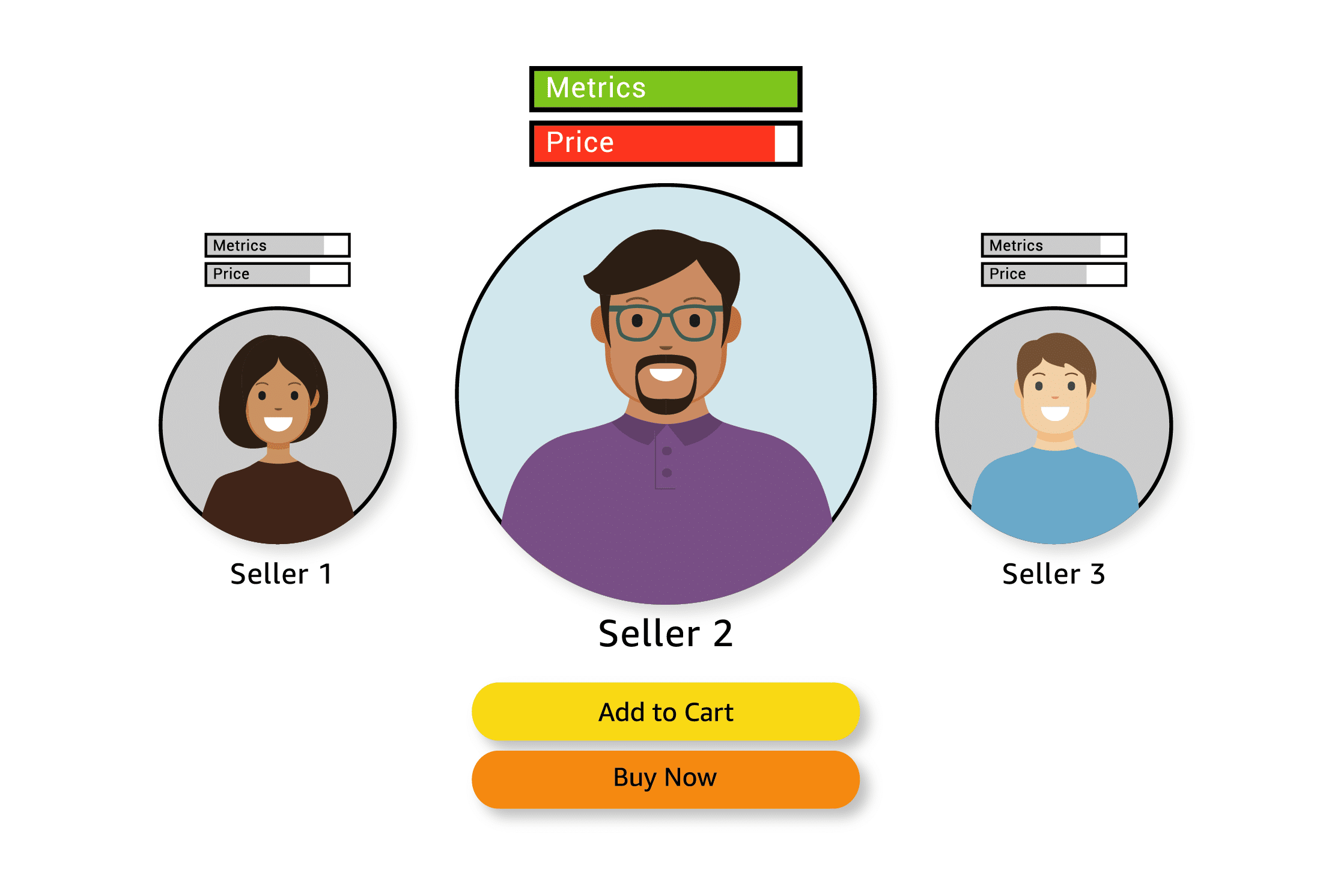
Of course, this matters more to arbitrage sellers than to private-label sellers because the former is always in competition with others in the same listing. On the other hand, while private-label sellers are almost always guaranteed the Buy Box, repricing still matters because it keeps their products competitive with other brands and optimizes profit margins.
Related Reading: Amazon Arbitrage
Reason 2: To clear out old inventory
This is especially important for seasonal products and products that expire. You certainly don’t want to leave them in Amazon’s warehouse, gathering dust and accumulating storage fees.
Reason 3: To make up for sales and offers
You may be offering discounts during sales events like Black Friday. With a repricing strategy, you can price your products higher when the opportunity presents itself so you can make up for those discounts.
Does Repricing Always Mean a Race to the Bottom?
No. Contrary to popular belief, repricing doesn’t always mean you should be aiming for the lowest price possible. Remember, you’re here to make a profit.
In fact, having a repricing system in place will make it easier for you to increase your prices if needed. Here are some of the situations when you should reprice upwards:
#1: When you have the Buy Box
You’ve done your part of being a good seller to increase your seller metrics. You’ve priced your products low enough to get a share of the Buy Box. Now that you have it, you have a little more room to increase your prices to optimize profits.
#2: When sales are slow
Revisit your sales history to know which days or times of day your product doesn’t sell as many units. During these times, you can program your repricer to set the prices higher. This way, you can maximize your profits on the sales you make when you need it most.
#3: When there’s a price war
Here’s the situation: A seller starts setting their prices lower. Another competitor notices this and lowers their price too so they can remain competitive. All other sellers follow suit, and now, everybody wants to sell cheaper.
This is what a price war looks like. But as with anything in life, you should choose your battles wisely. And this is one we recommend you shouldn’t participate in.
Factors to Consider When Repricing
Here are the things you should keep an eye on before repricing your products on Amazon.
#1: Your Capital and Profit Margin
Unless you’re still in the honeymoon period as a new seller and/or launching a new product, you should not sell at a loss. You’re not here to sell more products just for the sake of it. You’re here to earn.
#2: Competitors’ Prices and Repricing Frequency
How much are your competitors selling the same products for and how often do they change their prices? Consider these especially when you don’t own the Buy Box. But once you do, reprice upwards.
Keepa is a great tool for getting an overview of an item’s price history.
#3: Age of Inventory
Products about to expire? It’s time to grease the wheels by lowering the prices.
#4: Method of Fulfillment
If you’re an FBA seller, you’re automatically eligible for Prime, so metrics-wise, you are at an advantage over your FBM competitors. You can exclude them when you’re setting up your repricing rules.
#5: Product Seasonality
Holidays coming to an end? Do your best to get rid of your Christmas products by pricing them lower.
#6: Buying Cycles
Less costly products have shorter buying cycles, and you can’t reprice these as frequently as you would a product with longer buying cycles. Take for example tissue paper and cellphones. Put yourself in the shoes of the buyer. If you were someone who’s looking to buy a phone (a quite expensive purchase), you won’t immediately buy the first thing you see. You’ll research on it for days, maybe even months. So if the price fluctuates all the time, the buyer will find it off-putting if the price goes up.
Best Practices When Repricing on Amazon
Include all costs when setting prices and repricing rules.
Don’t be the seller who takes into account only the prices quoted by suppliers. We could not stress this enough: know exactly how much each unit costs initially. Include 3PL costs, paid promotions, etc.
Only then can you really determine how much the unit cost is and what prices you need to set as minimum and maximum, which we’ll be discussing next.
Always set a minimum price.
Whether it’s a manual error or an automatic repricer’s error, setting a minimum price can save you from accidentally giving away your products for less.
To choose your minimum price, consider your overall costs and how much profit you want to make. In other words, make it a profit-based minimum price. This way, you will never sell at a loss because you have a safety net.
Consider lead times and the overall condition of global supply chains.
This applies more to private-label sellers. Imagine this. The holidays are coming, and your competitors are all ready to give discounts on their items.
Before you join the trend, look at how the global supply chain is doing. Does it look like you and your competitors are going to receive your inventory on time?
If not, then let them price their products lower. When they run out, you can then have your products sold at a regular price. This way, you maximize your profit without really doing anything.
However, you should also consider the seasonality of your products and your competitors’ remaining stocks.
Don’t consider all sellers.
If you’re an FBA seller, you shouldn’t worry much about FBM sellers who sell similar products. You’re already at an advantage because of your Prime eligibility, and you have different storage and shipping costs to consider. Pick sellers that more or less operate the same and are considering the same factors as you.
Always double-check your repricing settings.
You may have the best repricing plan in mind, but when the execution fails, it wouldn’t matter much. So when you determine your minimum price should be $19.50, make sure you enter $19.50 and not $1.95.
Ensure your share of the Buy Box.
As mentioned earlier, one of the situations when you can reprice upwards is when you have the Buy Box. So maintain healthy seller metrics to ensure your share, and as much as possible, go for FBA.
Also, remember that even if you’re a private-label seller who’s usually guaranteed the Buy Box, there are ways you can lose it.
Types of Repricing Methods
There are three main repricing methods you can use for your Amazon products. Let’s discuss how they work.
Manual Repricing
If you’re still starting out on Amazon and you have only a few products to manage, manual repricing may be enough.
Here’s how you reprice your Amazon products:
- Log in to Seller Central.
- Hover over on Inventory and click “Manage Inventory.”
- Click on “Active” so you’ll only have to deal with products that you have in stock and whose listings are live. (On this note, make sure you don’t have any stranded inventory.)
You can see what the lowest price of the product is. If you’re offering the lowest price, a green checkmark will appear.
If you don’t already have the lowest price, you can click on “Match Low Price” or set your own by simply editing your current prices.
Manual repricing is okay if you’re just starting out, but as you can imagine, it’s not an efficient way of repricing in the long run, especially when you add more products.
Rule-Based Repricing
In rule-based repricing, you get to set your own rules to tell your repricer what to do when a certain situation comes up. You’re basically setting up if-then statements, mainly based on your competitors’ prices.
For example, you can set your repricer to automatically adjust your price to always be 50 cents cheaper than that of your competitors.
This can be problematic for obvious reasons. You’ll always be lowering your prices relative to your competitors, which means when there’s a race to the bottom, you’ll always win, but not in a good way.g That is why we recommend setting a minimum price.
Algorithmic Repricing
This method uses machine learning and considers a lot more factors in repricing aside from just your competitors’ prices.
It considers your seller metrics, market trends, and others so you can immediately reprice up when the situation presents itself. This is by far the most efficient repricing method, but most repricing tools are not free.
| Pros | Cons | |
|---|---|---|
| Manual |
|
|
| Rule-Based |
|
|
| Algorithmic |
|
|
Tools for Repricing Your Amazon Products
Repricing is essential to your Amazon business, but not all of us can afford to sit in front of our computers all day to monitor every change.
Fortunately, there are Amazon repricing tools readily available. Here are some of the most popular ones.
| Repricer | Price | Trial Period |
|---|---|---|
| Profasee | Varies | N/A |
| RepricerExpress | >Annual Plans: From £59 per month to £899 per month >Monthly Plans: From £79 to £1,199 |
14 days |
| Seller Active | >Basic Plans: From $129 to $399 per month >Pro Plans: From $624 to $1074 *amounts inclusive of repricing add-ons |
30 days |
| Repricer.com | >Annual Plans: From $79 per month to $1,199 per month >Monthly Plans: From $99 to $1,499 |
14 days |
| Seller Snap | From $250 per month to more than $800 per month for unlimited users and multiple stores | 15 days |
| BQool | >Annual Plans: From $22.50 per month to $270 per month >Monthly Plans: From $25 to $300 per month |
14 days |
| Feedvisor | Depends, but expect to pay upwards of $1,000 per month | N/A (but demo is available) |
| RepriceIt | From $9.95 per month to $79.95 per month | 30 days |
RepricerExpress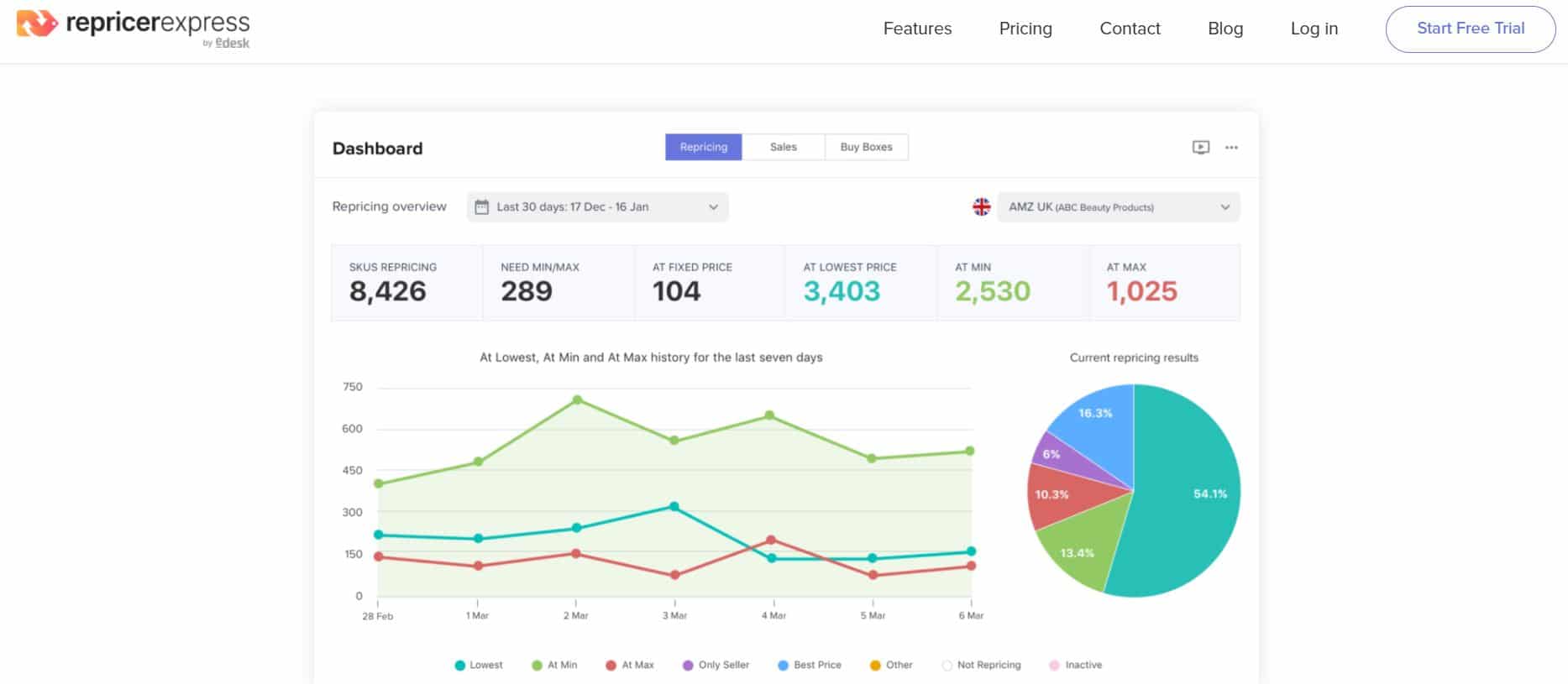
One of the best things about RepricerExpress is that if you’re selling on both Amazon and eBay, you can sync the prices based on the repricing rules you set up. If those are the two platforms you use, then this is the repricing app for you. It also has pre-made templates, which you can use or tweak.
The Safe Mode comes in handy when you just want to play around with the app as you’re learning how it works without the new prices going live.
If you take our advice about weeding out the competitors that don’t really matter when you’re repricing, RepricerExpress can help you easily filter out other sellers based on their country, top-rated status, feedback rating, etc.
It works with 11 Amazon marketplaces.
SellerActive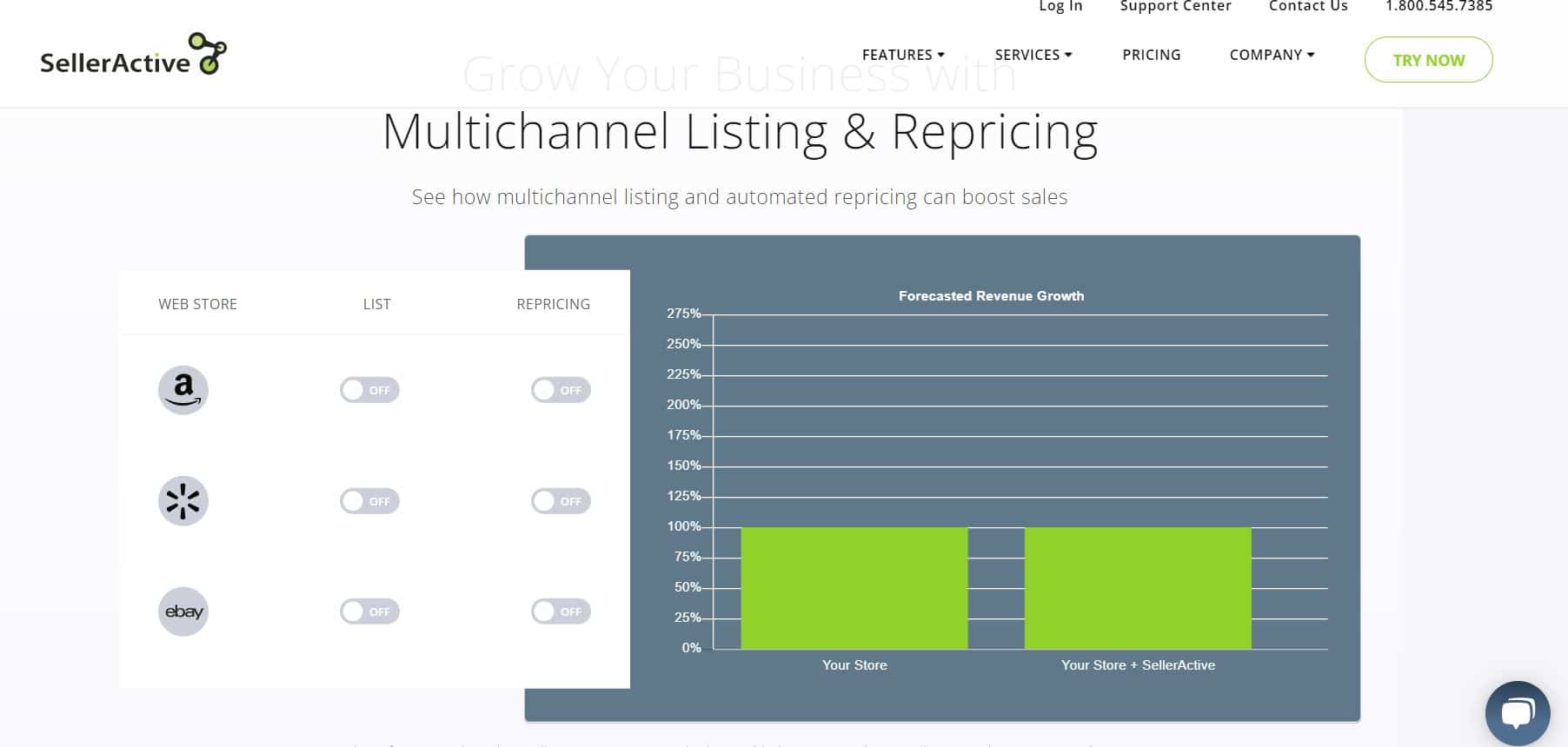
SellerActive is not only a multi-channel repricing tool—it also supports multiple integrations. So if you have more than one Amazon or Shopify store, you can easily control both from a single login. You do have to create a new SellerActive account for this and call their Customer Support to link them, but this is free of charge.
You can also integrate SellerActive with Quickbooks and SKUVault to better keep track of your inventory and revenue.
It works with 8 Amazon marketplaces.
Repricer.com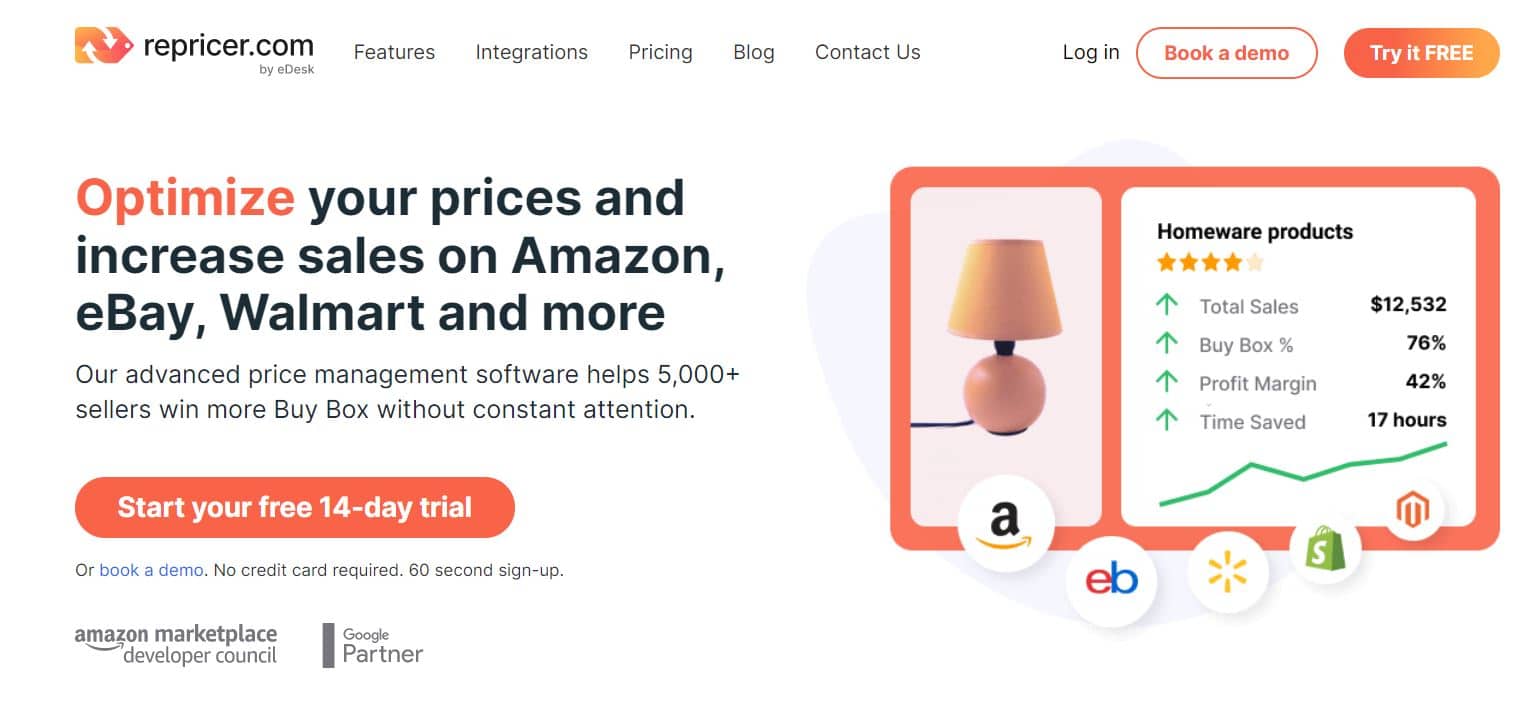
Repricer.com, formerly known as xSellco, is an Amazon repricing tool that works on 14 Amazon marketplaces as well as eBay, Walmart, and Shopify. It’s a member of the Amazon Marketplace Developer Council, a group of third-party software providers that deeply integrate with Amazon.
Repricer.com has a variety of convenient repricing templates that segments your competitors into FBM, FBA, and Prime. The FBA Rule, for example, reprices your products to allow you to compete with FBA sellers while maintaining the price above FBM. The FBM Rule, on the other hand, lets you compete with FBM merchants while going below FBA.
Seller Snap
One of the reasons why sellers use a repricer is so that they don’t have to manually change their prices. However, with rule-based pricing, you’ll often have to check if the rules are still effective for that particular day. Seller Snap fixes this by using AI-powered game theory repricing.
With this technology, you can automatically avoid price wars because it detects if your competitors are starting to price lower and immediately brings your prices up, stopping you from participating in the race to the bottom.
Seller Snap also works with all Amazon marketplaces and is integrated with SKUVault. However, it doesn’t give out real-time sales data and is pricier compared to other repricing tools.
BQool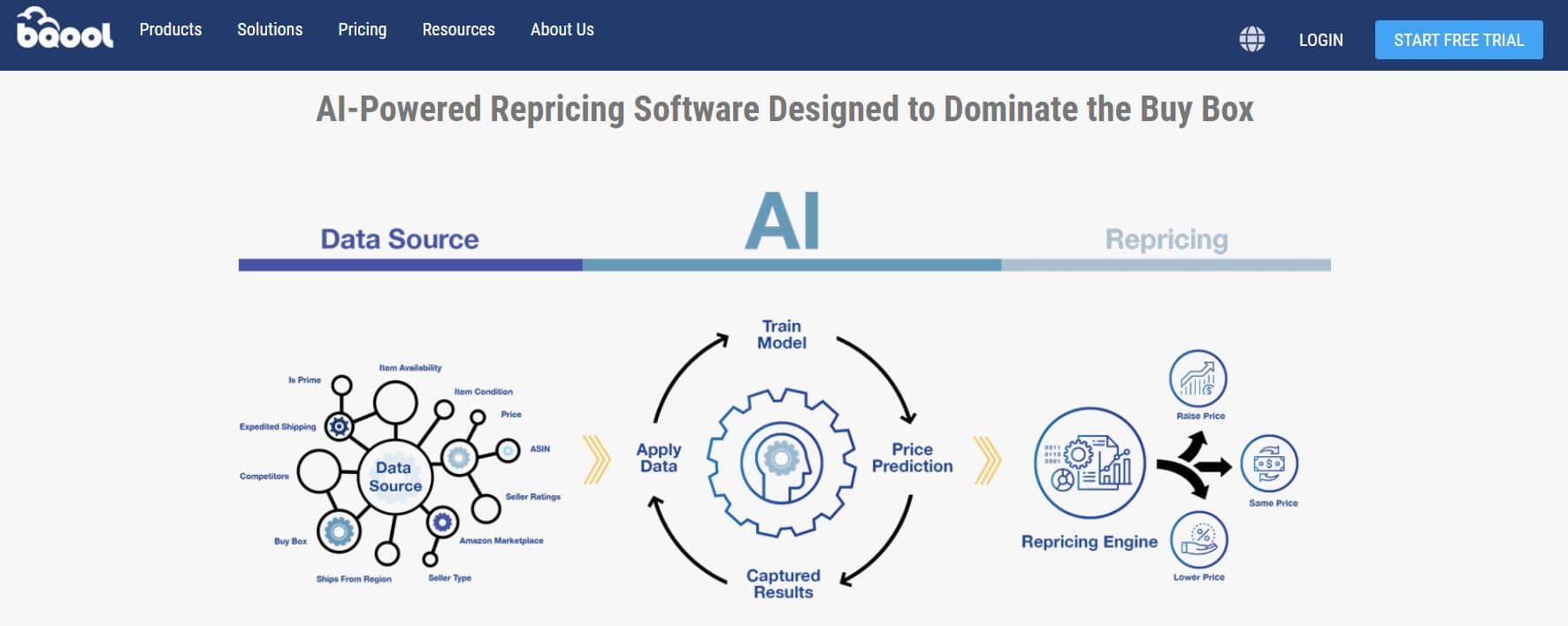
This AI-powered app optimizes your prices every 5 to 15 minutes. It works with 9 Amazon marketplaces, synchronizes with Inventory Lab, and has an embedded price and profit calculator. The calculator considers your Amazon fees, shipping expenses, and EU VAT fees.
It works with 9 Amazon marketplaces and has a repricing history log.
Feedvisor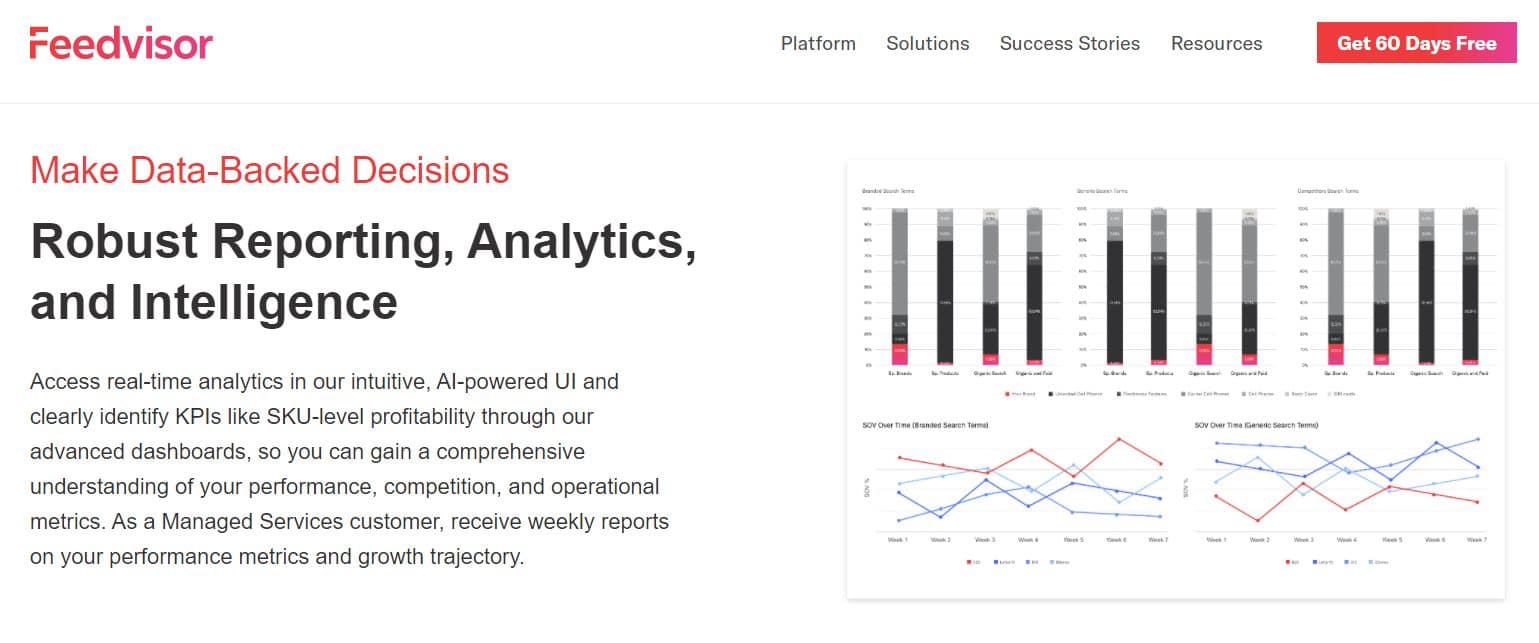
Just like Repricer.com, Feedvisor is also part of the Amazon Marketplace Developer Council. It is powered by an AI algorithmic repricer and updates prices every fifteen minutes.
Feedvisor enables sellers to reprice across multiple marketplaces, including your own e-commerce site. It’s also especially useful for book resellers because you can choose the book’s condition, e.g., collectible, so you can reprice based only on specific conditions.
However, this app is designed for established sellers who are doing at least $100,000 a month in sales. Expect to pay at least $1,000 per month, and there are no free trials for Feedvisor (only a demo is available).
Conclusion
Amazon sellers, whether they’re into private labeling or arbitrage, need to know how and when to reprice their products to maximize profits. Keeping your prices stagnant results in missed opportunities, and any business owner wouldn’t want that.
What’s your repricing strategy? Share it with us in the comments.
